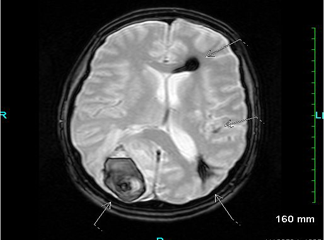- Clinical Technology
- Adult Immunization
- Hepatology
- Pediatric Immunization
- Screening
- Psychiatry
- Allergy
- Women's Health
- Cardiology
- Pediatrics
- Dermatology
- Endocrinology
- Pain Management
- Gastroenterology
- Infectious Disease
- Obesity Medicine
- Rheumatology
- Nephrology
- Neurology
- Pulmonology
Intracranial Bleeding From Cerebral Amyloid Angiopathy
A 59-year-old woman with chronic hepatitis C presented with abdominal pain that had grown progressively worse during the past 3 months.

A 59-year-old woman with chronic hepatitis C presented with abdominal pain that had grown progressively worse during the past 3 months. After portal vein and superior mesenteric vein thrombosis were identified as the source of the abdominal complaints, warfarin therapy was initiated. The patient was then transferred to a tertiary facility for possible embolectomy.
At the tertiary facility, the patient developed a severe headache with nausea, vomiting, and right-sided weakness. CT of the brain showed left frontoparietal intracranial bleeding. Although warfarin was discontinued, there were 2 instances of rebleeding. The patient received conservative treatment and was sent to rehabilitation.
Routine abdominal ultrasonography for hepatoma surveillance found new infiltrative liver lesions. Results of the subsequent biopsy revealed hepatocellular carcinoma. The patient was referred for tumor embolization.
Before the start of treatment, the patient developed severe right-sided headache, nausea, and vomiting, with visual field defect. Emergency CT of the brain revealed a hemorrhagic lesion in the right superior parietal lobe cortex/subcortex. To investigate the possibility of tumor bleeding, MRI of the brain was obtained; scans revealed a right posterior parietal lobe hematoma (Figure). Gradient echo MRI showed a small focus of low signal intensity in the left parietal subcortical white matter, most likely the result of hemosiderin deposition from a prior bleeding episode and compatible with a diagnosis of cerebral amyloid angiopathy (CAA). The patient received conservative treatment and was sent home with residual right sided weakness and visual field defect.
CAA is usually asymptomatic but is an important cause of lobar hemorrhage. It can occur as a sporadic disorder, sometimes in association with Alzheimer disease, or as a familial syndrome. CAA is characterized by the deposition of congophilic material in small to medium-sized blood vessels of the brain and leptomeninges. In the most severe stages of CAA, the amyloid deposits cause breakdown of the blood vessel wall with resultant hemorrhage.
Hypertensive vasculopathy is the most common cause of spontaneous intracranial hemorrhage (ICH). CAA is the most common cause of non-traumatic lobar ICH in the elderly. Vascular malformations are the most common cause in children.1 Additional causes of non-traumatic ICH include:
• Hemorrhagic infarction (including venous sinus thrombosis)
• Septic embolism, mycotic aneurysm
• Brain tumor
• Bleeding disorders, anticoagulant therapy, thrombolytic therapy
• Central nervous system infection (eg, herpes simplex encephalitis)
• Moyam
• Vasculitis
• Drugs (eg, cocaine, amphetamines; phenylpropanolamine may be an independent risk factor for intracranial hemorrhage in women).
Neuroimaging with brain CT or MRI is essential to confirm the diagnosis of ICH and to exclude ischemic stroke and stroke mimics. Both CT and MRI are considered first-choice imaging options for the emergency diagnosis and assessment of ICH.2,3 Acute ICH can be diagnosed by MRI with up to 100% sensitivity and accuracy by experienced readers.4
Hemorrhages related to amyloid angiopathy are usually lobar, but can be occasionally cerebellar. They predominantly involve the posterior portions of the brain, including the parietal and occipital lobes. The hemorrhages are usually multiple at presentation. Neuroimaging data suggest that small subclinical leaks of blood called cerebral microhemorrhages are relatively common in CAA. Gradient-echo MRI may reveal old small hemorrhages. Patients with amyloid angiopathy are typically over age 65 years. In a retrospective case-control study, superficial siderosis was detected on MRI in 60% of patients with pathologically confirmed CAA, but in none of the cases of ICH that were pathologically determined to be unrelated to CAA.5 However, superficial siderosis can have a number of other unrelated causes (eg, prior trauma, vascular malformation). The prognostic significance of this finding and its association with CAA require further study.
Acute CAA- related hemorrhage is treated like other acute ICH, with attention to intracranial pressure and control of blood pressure. Short-term empiric use of anticonvulsants is reasonable in lobar hemorrhage, particularly if the patient is at risk for aspiration or other medical complications. Surgical resection of hematoma in cases of CAA appears to carry little or no additional risk compared with surgical treatment of other types of ICH and can be performed when indicated.
References:
References:
1.
Beslow LA, Licht DJ, Smith SE, et al. Predictors of outcome in childhood intracerebral hemorrhage: a prospective consecutive cohort study.
Stroke.
2010;41:313-318.
2.
Broderick J, Connolly S, Feldmann E, et al. Guidelines for the management of spontaneous intracerebral hemorrhage in adults: 2007 update: a guideline from the American Heart Association/American Stroke Association Stroke Council, High Blood Pressure Research Council, and the Quality of Care and Outcomes in Research Interdisciplinary Working Group.
Stroke.
2007;38:2001-2023.
3.
Kidwell CS, Wintermark M. Imaging of intracranial haemorrhage.
Lancet Neurol.
2008;7:256-267.
4.
Fiebach JB, Schellinger PD, Gass A, et al. Stroke magnetic resonance imaging is accurate in hyperacute intracerebral hemorrhage: a multicenter study on the validity of stroke imaging.
Stroke.
2004; 35:502-506.
5.
Linn J, Halpin A, Demaerel P, et al. Prevalence of superficial siderosis in patients with cerebral amyloid angiopathy.
Neurology.
2010;74:1346-1350.
